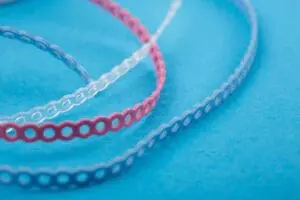Back to basics: 10 Interesting Tips for Orthodontic Space Closure
Introduction and a COVID Christmas.
I am currently recovering from a particularly nasty case of “the COVID” and am experiencing a bit of brain fog. As a result, I have gone for an easy option and got Padhraig Fleming to do the first post of the year. This is part of the “Back to Basics” series. He discusses a combination of evidence and his personal clinical tips on orthodontic space closure.
Background and evidence
Space closure is a discrete phase of treatment treatment. With few exceptions, it follows initial alignment and precedes finishing and detailing.
Numerous excellent studies have considered the relative effectiveness of various mechanics and force levels to affect space closure. These have typically suggested that there is little to choose between NiTi closing coils and elastomeric chain (Dixon et al., 2002; Nightingale and Jones, 2003) and that force above 150g appears unnecessary (Samuels et al., 1998). There have been several other studies (and indeed related systematic reviews), but, in a nutshell, these are the findings. So, that’s the evidence, but what about the experience?
At the outset, it is important to highlight that studies considering space closure typically focus somewhat rigidly on the rate only (in mm per month). This reflects our ability to measure this easily, while other important effects (and side effects) are much harder to quantify. However, given that space closure is sandwiched between other phases of treatment and precedes finishing and detailing. As a result, space closure must occur efficiently and in a controlled manner with minimal side effects and careful inter-arch management in all three spatial planes. Failing this, our efforts to recover from these unwanted changes will negate the benefits of more rapid space closure.
Below, I have outlined several things I do and consider during space closure. As with much of orthodontics, there is evidence to underpin some of the following; however, I have to highlight that much of the following has no evidential basis, and some are relatively intangible.
So here are 10 top tips (I have to confess to having settled on ten primarily for roundness):
1. Force Levels to commence Space Closure:
There is almost a truism that we should keep forces light during orthodontics. I agree with this but believe that we rarely measure forces. And indeed, forces are essentially indeterminate during many treatment phases. In terms of space closure, I do think that the use of light forces is sensible. I also, however, feel that the force required to initiate space closure may differ from that needed to continue the movement of a moving tooth.
2. Force Levels to Continue Space Closure:
As mentioned above, lighter forces are probably better. Therefore, I (like most of you, I’m sure) look for wire emerging through the terminal molar tubes to evaluate how efficiently space is closing. If I see lots of space closure happening, I do my best to do absolutely nothing (Other than snip the wire and reassure the patient that I am not lazy!). Why do I take this approach? Two reasons:
1. As per the above, lighter forces may be helpful, and I don’t see the merit in increasing the force levels.
2. Increasing the force will increase the risk of adverse local effects (Discussed below).
3. Avoid applying space closure mechanics to the terminal molar in the lower arch.
Space closure in the lower arch is often more complex. However, controlling intra-arch features (chiefly tip, torque and rotational control) is also more challenging during lower arch space closure. Lower molars tend to rotate (mesio-ligually or disto-buccally) during space closure. This effect is amplified if we do not have the control offered by the wire extending to the second molars. Some of my clinical teachers tried to convince me that the elastomeric chain was the culprit here. I disagree and think that this is a geometric issue.
I, therefore, try to avoid running space closing mechanics to the terminal molars and rely on trans-septal fibres to allow for passive mesialization of the 7s if applying mechanics to the 6. The latter does not always happen but often does in the presence of an intact periodontium. If space does appear distal to the first molar, a brief period of force application to the terminal molar will be required.
4. With anterior spacing, consider varying the terminal tooth.
I see many clinicians who exclusively run space closing mechanics from molar to molar, etc. I don’t like this approach (partly because of 3 above). Therefore, I try to vary where my chain terminates. I often run a chain from 4-4 and then transition from 5-5 if residue exists. Why? Again, there are two reasons:
1. by repeatedly terminating the chain on the same teeth, I think we run a higher risk of producing rotation of these teeth. Stainless steel ligatures are not infallible and do become lax over time.
2. By avoiding extending the chain to the molars, we may end up with a minor amount of space distal to the premolars, which we can manage easily to address inter-arch relationships. I feel that I am less likely to affect molar position (and therefore critical molar anchorage) by taking this approach.
5. Consider wire dimensions.
Like others, I tend to space close on working (19×25-inch) SS in an 0.022-inch slot. However, I do always think about this and am less prescriptive in adults, in particular. Clearly, there is a trade-off between efficiency, the stage at which we can start (as progressing to 19×25-inch SS might require an additional visit to align the slots fully), and the potential for side effects. As knowledgeable and discerning clinicians, our job is to weigh these up.

6. Chain or coils?
i. Elastomeric materials have advanced very significantly in recent years. We now have much more robust materials, which may decay more slowly.
ii. As mentioned above, the force to move moving teeth is likely lower than that needed to initiate movement. Hence, force decay might well not be the negative that people consider it to be during space closure
iii. Ease of use: Chains are simple to place and remove, can be varied across dental segments more easily and are available in colours for children
I would, however, caution that many of the chains now available are very taut and more akin to tape. As per 1 and 2, assessing whether the force levels are appropriate for the given situation is worth assessing.
7. Timing of space closure.
This is a very important one. Again, we lack plentiful evidence on this one (Almaasarani and Rajeh, 2023; Hasler et al., 1997), but there is no doubt that early space closure following extractions facilitates more rapid tooth movement. This is, I think, of particular use in adult patients where space closure may be more challenging. I rarely let extraction spaces in adults mature.
Similarly, I tend to be more proactive in dealing with anterior spacing. This is unaesthetic and often more challenging to close. I will, therefore, consolidate this relatively early. In some cases, this is likely to precede formal space closure in the posterior region. However, I will also often close (at least the majority of) extraction spacing following the removal of lower incisors early (It goes without saying that we need to factor in our anchorage demands before doing this).
8. Dealing with iatrogenic effects.
Adverse intra-arch effects (including tipping, rotation and torque changes) and resultant inter-arch problems, including transverse coordination problems and local open bites, can arise during space closure. Why? Because we use undersized wires, the active forces we deliver are typically not directed through the centre of resistance of the teeth. This can be exacerbated by excessive force levels (and frequent reactivation) or the use of particularly undersized wires.
Therefore, removing, inspecting, and adjusting our wires during space closure is good practice. This can allow us to remove debris and address any bowing effects and distortion of the wire. We may also need to consider changing the wire dimensions (mainly if we commenced on undersized wires), placing bends or accentuating compensatory curves if required.
9. Think about your cinch.
Many of us don’t cinch wires during space closure. I tend to, as I don’t like the idea of wire emerging horizontally from the molar tube. It is essential, however, that the direction of the cinch does not impede tooth movement. I, therefore, tend to cinch vertically in the upper arch. In the lower, I will review the anatomy, but again, I will often cinch vertically but sometimes also lingually distal to the terminal molar.
10. Be proficient in the use of closing loops.
I have focussed the above on the use of sliding mechanics. However, we know that we encounter complicated situations (and ironically times when we feel that the only recourse might be to very high force levels indeed). However, closing loops are a fantastic tool to have at our disposal. This came to my rescue at one point in my career when I inherited a tranche of transfer cases, which had included loss of lower premolars in Class II division 2 type cases with very deep overbites. These mechanics offer the flexibility to close space efficiently while simultaneously managing vertical issues.
So, they are my current 10 Top Tips on Orthodontic Space Closure. I hope you find these useful, and even if you don’t agree with some, they make you look at your space closure a little more closely.
I am grateful for other thoughts, suggestions and better tips!
A version of this post was originally published on the Orthodontic Fundamentals Facebook group.
References

Professor of Orthodontics, Trinity College Dublin, The University of Dublin, Ireland
Nice analysis. The point of application of the force(s) is of great importance to control the moment to force ratio and decrease binding and friction. The use of power arm and correctly constructed closing loops considerably teduce side effects and speed up treatment.
How to avoid rotation of terminal premolar when using power chain 4-4 or 5-5
Try to limit the time that the chain is terminating on any tooth. So vary the terminal tooth from visit to visit. At least that’s what I try to do! … And careful ligation obviously.
Thanks!
Closing loops, especially with ceramic bracket systems, can get you out-of-jail!
BWs
Adey Bennett
Great to get such a strong clinical input to our knowledge, which is rare to find